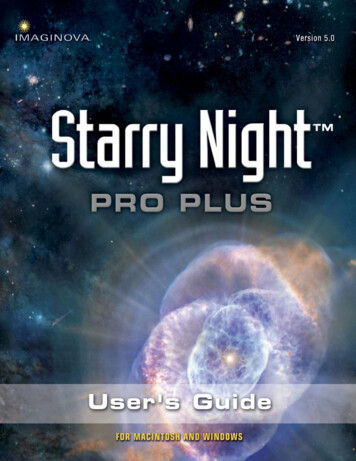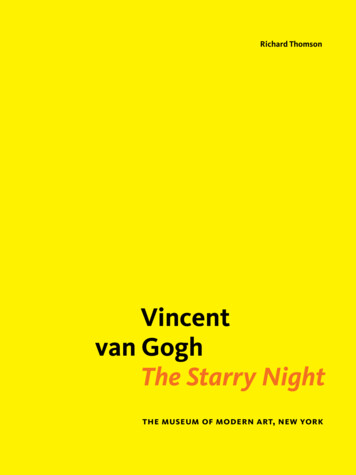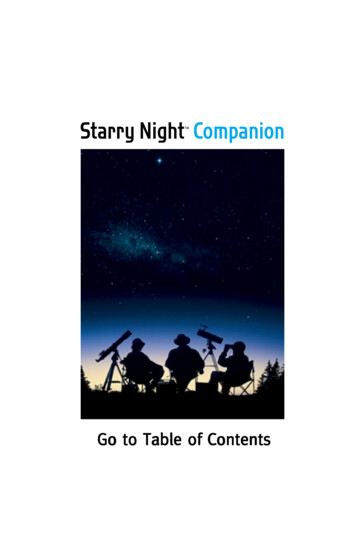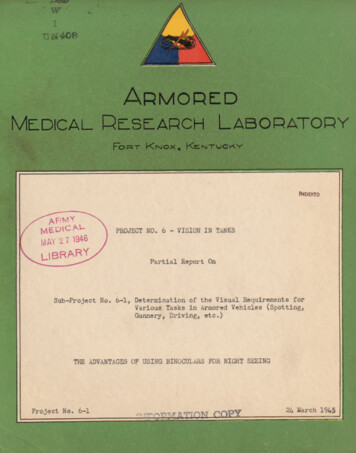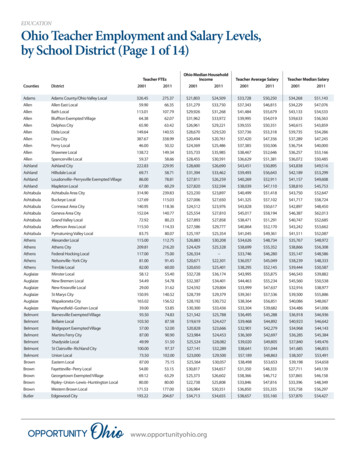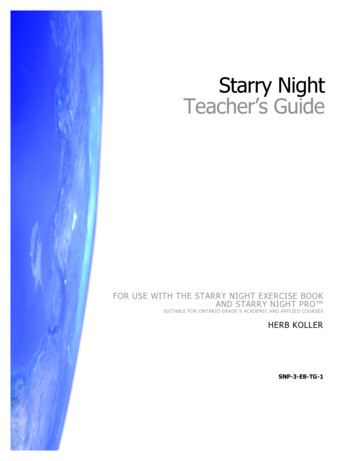
Transcription
Starry NightTeacher’s GuideFOR USE WITH THE STARRY NIGHT EXERCISE BOOKAND STARRY NIGHT PRO SUITABLE FOR ONTARIO GRADE 9 ACADEMIC AND APPLIED COURSESHERB KOLLERSNP-3-EB-TG-1
Herb Koller, B.Sc.The author is an educational consultant with 33 yearsteaching experience, including 25 years as a high schoolscience department head. Mr. Koller earned his B.Sc. atthe University of Waterloo and is an active member of theAAVSO (American Association of Variable StarObservers) and the RASC (Royal Astronomical dbackWe welcome your feedback atExercises@siennasoft.com.Permission to CopyPlease make copies or edit the materials in this book inorder to better teach astronomy!All parts of this book may be reproduced by anymechanical, photographic, or electronic process, stored ina retrieval system, transmitted and otherwise copied forthe purposes of advancing astronomy education whenused with Starry Night astronomy software.Any other uses, including reproduction for resale, arestrictly prohibited.AcknowledgementsMany thanks to Andrew Angus, Michael Goble, MikeParkes and Steve Smallwood for "beta-testing" theExercise Book, Mark Dykstra for his formatting skillsand Peter Forint and the Sienna team for helping to makeit all happen.First Edition, Copyright 1999 Sienna Software, Inc.http://www.siennasoft.com
Table of ContentsObjectivesGetting Started . 4Exercise 1: Using Starry Night . 4Exercise 2: The Constellations . 5Exercise 3: The Solar System . 5Exercise 4: Diurnal Motion . 5Exercise 5: Direct Motion . 5Exercise 6: Retrograde Motion . 6Exercise 7: Building a Deep Sky Database . 6APPENDIX: Ontario Grade 9 ScienceCurriculum Correlation . 6AnswersExercise 1:Exercise 2:Exercise 3:Exercise 4:Exercise 5:Exercise 6:Exercise 7:Using Starry Night . 7The Constellations . 7The Solar System . 8Diurnal Motion . 9Direct Motion . 10Retrograde Motion . 10Building a Deep Sky Database 11BibliographyBooks . 13Magazines . 13
ObjectivesWelcome to the Starry Night Grade 9 teacherscurriculum resource. This resource consists of threeparts: the Student Exercise Book, Starry Night PreparedFiles and this Teachers Guide.The Student Exercise Book and the Teachers Guide arein Adobe PDF format and the Prepared files are filesrecognized by Starry Night Pro.Getting Started1Load Starry Night Pro on as many computers as yourlicence permits following the instructions suppliedwith the software.2The first time you run the software, it will ask you toset a location. If your city or town is not listed,choosing a nearby listed city will usually besufficient. Or you can enter the latitude andlongitude of your location if known. Make sure youalso check the correct time zone.3The Starry Night Prepared Files should be placed in aconvenient place -- the desktop or the Starry NightPro folder are possible choices.4Make a backup copy of the Starry Night PreparedFiles in case students make and save changes.Exercise 1: Using Starry NightObjective:To practice using the time controls.
ObjectivesTime Required:15 - 20 minutes1The Sun file models the solar eclipse of July 11, 1991as seen from South America. Students could find theactual location on an atlas by using the latitude andlongitude given on the Tool Palette under Location.2When analyzing the orbit of Halley’s comet, don’tworry about getting exact dates. Thesimulation does not take into account planetaryperturbations and the resulting orbit is onlyapproximately correct. Nevertheless, the studentsshould be able to make relatively decent predictionsfor the return of Halley’s comet.3The Extension questions can lead to a group or classassignment or discussion on the various solar systemmodels.Notes12A lot of the work in these exercises involves the useof the time controls. It is therefore critical that youand the students know how to use them. Exercise 1should give sufficient instructions but it is a wiseidea to check the users manual supplied with thesoftware as well. Make sure students know thedifference between a single step and continuous flowof time.It is always a good idea to close files when they areno longer needed. If given the option, studentsshould always choose Don’t Save when closing thesefiles. (But you do have backup copies of the preparedfiles — don’t you?)Exercise 2: The ConstellationsObjectives:1To learn some constellation names2To be able to find PolarisTime Required:20 to 30 minutesExercise 4: Diurnal MotionTo “discover” the westward motion causedby the rotation of the earth.Objective:Time Required:Notes1Along with Exercise 5 and 6, this exercise allowsStarry Night to “shine”. (sorry!) Observations whichrequire days, months or even years can be completedin minutes and any difficult parts can be viewed overagain.2Encourage students to describe motions usingcardinal directions rather than “left” or“right”.3You can pass along this neat trick – turn off daylight(Display Daylight) to see stars all day long!4If you wish to try question 2 of the Extensions,change location to the north pole by clicking on thelatitude (e.g. 44N) shown in the Control Panel andenter 90. Enter 0 to quickly get to the equator.Notes12A small project might be to come up with a moreimaginative outline for Orion. This could become aclass contest!Extensions are presented here for the first time.These questions and activities are optional (at yourdiscretion) but they do allow faster students to workahead and can serve as homework or projectassignments.Exercise 3: The Solar System30 - 40 minutesObjectives:1To introduce various objects in the solar system.Exercise 5: Direct Motion2To make predictions based on orbital information.Objective:Time Required: 30 - 40 minutesNotesTo show that the sun and planets moveagainst the background of the stars.Time Required:25 - 35 minutes5
ObjectivesNotes124Students may notice that using the file Solar Motion,some (unmarked) planets tend to wander back andforth. Refer any questions about this odd behaviourto the next exercise.Students may need help to change the parameters onthe Time Palette from 1 sidereal day to 5 days.Exercise 6: Retrograde MotionObjective: To illustrate the apparent backward motion ofplanets as seen from earth.Time Required:20 - 30 minutesThe Internet resources given at the end of theexercise are a rich source of information on allaspects of astronomy. Check them out.APPENDIX: Ontario Grade 9 ScienceCurriculum CorrelationThe Starry Night Exercises will satisfy part or all of thelisted expectations.ExerciseAcademicApplied1: Using Starry NightESV.02ESV.022: The ConstellationsES1.01ES1.01,ES3.023: The Solar SystemES1.01,ES 1.03,ES2.09ES1.01,ES1.03,ES2.054: Diurnal Motion5: Direct Motion6: Retrograde MotionES1.01ES2.01ES2.05ES1.01ES2.087: Deep Sky DatabaseES2.05,ES2.07ES2.05,ES2.06Notes1Make sure Exercises 4 and 5 have been completedbefore trying this one.2By now students should have no difficultymanipulating the time controls to move Mars backand forth along its displayed track. Don’t worry ifpart of the track is erased; it will be redrawn whenrequired.3The file retro2 shows a top-down view of the innersolar system. The orbits of Mercury, Venus, Earthand Mars and the asteroid Vesta are shown. The mainconcern here is that students understand that theretrograde motion seen from Earth is caused byone planet (i.e. the Earth) passing another.Exercise 7: Building a Deep Sky DatabaseObjectives:1To gather information in a database.2To introduce some of the best deep sky objectsvisible from earth.Time Required:325 - 35 minutesThe results of this exercise can be recorded in acomputerized database manager and then sorted tohelp answer the questions.6
AnswersThe following are suggested answers or answers that astudent might supply. Please note that other validanswers are possible.Exercise 1: Using Starry Night3. Try It Outa)Stars and Constellations have shifted from SE to SWand time has advanced by 3 minutes.b)Stars and constellations remain in same relativeplace. Sun and object near top move a bit.c)Stars and constellations shift westward.d)When a sidereal day has elapsed, stars are in the samerelative place, but after a solar day, they moveslightly westward.4. Using Prepared Filesa)Date - 3/26/1997 or 26 March 1997; Time - 2:16 amExercise 2: The Constellations1. Ursa Major and Ursa Minord)The constellations seem to be movingcounterclockwise around Polaris.
8Starry Night Exercise Book: Teacher’s Guidee)Some circumpolar constellations are Cepheus,Draco, Cassiopeia as well as Ursa Major and UrsaMinor.6. Summarya)Some constellations cannot be seen in the summerbecause: they are in a different part of the sky2. Orion daylight interferes.b)7. Extensionsa)All constellations visible are circumpolar as seenfrom the poles.b)All constellations rise and set at the equator.c)See various references.Exercise 3: The Solar System3. Winter Constellationsa)Canis Major – the great dogCanis Minor – the little dogMonoceros – the unicornTaurus – the bullEridanus – the riverLepus – the hare4. Spring Constellationsa)Virgo – the maidenLeo – the lionCancer – the crabCorvus – the ravenCrater – the cupHydra – the sea serpentLibra – the scalesComa Berenices – Berenice’s hair1. The Suna)The sun provides light, energy for plants to grow andkeeps the planets in their orbits.b)A solar eclipse is taking place. With the sun coveredno light reaches the earth.2. Other Members of the Solar Systema)The four inner planets are Mercury, Venus, Earthand Mars. Completing the list are Jupiter, Saturn,Uranus, Neptune and Pluto.b)The orbits of the planets appear to be circular moreor less centred on the sun.c)The earth appears to be closest to the sun on Jan 4.Some people find this surprising because theyexpect the earth to be closest to the sun in thesummer.d)Vesta’s orbit seems similar to a planet’s orbit.e)Halley appears to be a comet because it has a taillike a comet.5. The Stars of Northern Summersa)Aquila – the eagleSagittarius – the archerScorpius – the scorpionOphiuchus – the serpent bearerSerpens Caput and Serpens Cauda – the head andtail of the snake
Answersf)The orbit of Halley’s comet is much more elongatedthan a planetary orbit but Halley’s comet alsorevolves about the sun.2. Good Morning!a)The constellations rise from the eastern horizon andmove up and towards SE. The sky is getting brighterbecause it’s almost daytime.b)Yes, Venus shares the motion of the constellations.c)The sun is just about to rise near the SE.3. Orbitsa)b)The planets are moving counterclockwise around thesun. The closer a planet is to the sun the faster itmoves.Vesta moves just like the planets.Its speed is slowerthan Mars.4. The Orbit of a Comet3. Moving Ona)The sun rises near SE and moves up and towards thesouth (the “right”).b)The sun and the stars all move in an arc from east towest.a)Halley’s comet appears near the sun in Jan 1758.b)The comet should reappear between 1833 and 1834.c)The sun and stars sink towards the western horizon.c)Using a period of about 76 yrs, comet Halley shouldappear in 2062.d)Jupiter is located in the upper left in the constellationPisces.d)Comet Halley moves much faster when it is near thesun because the sun exerts a greater force on it.e)Jupiter, like the stars moves towards the westernhorizon.5. Extensionsa)Heliocentric means sun-centered.b)Geocentric models had the earth at the centre.c)Today we believe in the heliocentric model. The sunis the most massive member of the solar system andthus all objects less massive revolve around it.Exercise 4: Diurnal Motion1. Looking Arounda)Ophiuchus is near the eastern horizon.b)The bright object in Libra is the planet Venus.4. What about the Moon?a)Yes, the moon appears to move with the stars fromeast to west.5. Summarya)Diurnal motion is the daily motion of celestialobjects from east to west.6. Extensionsa)Yes, the stars appear to rise in the east and set in thewest.b)Diurnal motion appears to change with location. Atthe equator the stars rise straight up from the easternhorizon and set vertically towards the westernhorizon. Near the poles, the diurnal motion is almosthorizontal.9
10Starry Night Exercise Book: Teacher’s GuideExercise 5: Direct MotionExercise 6: Retrograde Motion1. The Moving Sun1. Mars in Motiona)The stars forming Leo are much further away thanthe sun.b)The sun appeared to move from W to SW (this is aneasterly direction).c)The earth has completed one rotation relative to thestars.d)24 hours minus 3 minutes and 56 seconds or about23 h 56 m.e)The sun should “visit” Virgo next.a)The moon passes Mars.b)Mars moves eastward against the background of thestars.c)The sun passes through the following 13constellations: Leo, Virgo, Libra,Scorpius, Ophiuchus, Sagittarius, Capricornus,Aquarius, Pisces, Aries, Taurus,Gemini and Cancer.f & g)h)All but Ophiuchus are constellations of the zodiac.2. The Eastward Motion of the Moona)b)The moon also moves eastward among the stars butat a much greater speed.Mars begins retrograde loop about 3/18 andcommences eastward motion about 6/4.f)Mars passes Spica near the beginning of June 1999.2. What causes Retrograde Motiona)Various student answers are possible at this stage.b)Earth is moving a little faster and, being on the“inside track”, passes Mars during this time interval.c)Mars continues moving in the same direction(counterclockwise) and never movesbackwards.The moon follows the ecliptic quite closely but doesmove slightly below or above.3. Summarya)d)The direct motion of the sun is caused by the earth’srevolution about the sun. Direct motion of the moonis caused by its revolution around the Earth.4. Extensionsa)The earth requires an extra 4 minutes to catch up tothe sun which has “moved” along the ecliptic.b)The phases are new moon, first quarter, full moonand last quarter.3. Summarya)Retrograde motion appears to be caused when Earthpasses Mars.
AnswersExercise 7: Building a Deep Sky Database1. The Messier CatalogStudents should be aware that the term light year is adistance and not a time measurement.2. Database of Deep Sky ObjectsNo.Type of ObjectName or Description of ObjectDistance {l.y.}In ConstellationM1supernovaremnantCrab nebula6 000TaurusM2globular clusterround mass of stars50 000AquariusM6open clusterButterfly cluster2 000ScorpiusM8cluster withnebulaLagoon nebula6 500SagittariusM11open clusterWild duck cluster6 000ScutumM13globularclusterHercules cluster25 000HerculesM17cluster withnebulaOmega nebula5 000SagittariusM20cluster withnebulaTrifid nebula2 200SagittariusM27planetary nebulaDumbbell nebula1 250VulpeculaM31galaxyAndromeda galaxy2 200 000AndromedaM42diffuse nebulaOrion nebula1 600OrionM44open clusterBeehive cluster500CancerM45open clusterPleiades400TaurusM57planetary nebulaRing nebula4 100LyraM81galaxyBode’s galaxy7 000 000Ursa Major11
12Starry Night Exercise Book: Teacher’s Guide3. Using the Databasea)Galaxies seem to be the farthest away from earth.b)They are all composed of a huge number of stars.c)Star clusters are often associated with nebulas.d)At a distance of over 2 million light years, an objectmust be huge to be visible to the naked eye.e)A lot of nebulas are associated with star clusters.The stars in these clusters should be very young.
BibliographyHere is a short list of print resources which may be of use.BooksDickinson, Terence. NightWatch , 3rd Ed. Willowdale, ON: Firefly Books Ltd. 1998.A superb introduction to observational astronomy. Highly recommended.Levy, David H. The Sky: A User’s Guide. Cambridge: Cambridge University Press1991.An introduction to observational astronomy by a world-famous amateur astronomer.Motz, Lloyd and Nathanson, Carol. The Constellations. New York: Doubleday 1988.This book explores the history, mythology and science of astronomy by examiningthe constellations for each season.Yeomans, Donald. Comets. New York: John Wiley & Sons 1991.A thorough history of the observation, myth and folklore of comets. Especially usefulis a table showing all comet Halley orbital elements from 466 BC to 2134 AD.MagazinesSkyNews. National Museum of Science & Technology Corp., Box 9724, Station T,Ottawa, Ontario, K1G 5A3.A Canadian astronomy magazine published six times a year with feature articles,observing information, a great star map and beautiful photographs. Highlyrecommended for the beginner.Sky and Telescope. 49 Bay State Road, Cambridge, MA, 02138.A more advanced, but excellent monthly magazine on astronomy with extensivefeature articles and observing information.
exercise are a rich source of information on all aspects of astronomy. Check them out. APPENDIX: Ontario Grade 9 Science Curriculum Correlation The Starry Night Exercises will satisfy part or all of the listed expectations. Exercise Academic Applied 1: Using Starry Night ESV.02 2: The Constellations ES1.01 ES1.01, ES3.02 3: The Solar System ES1.01,

